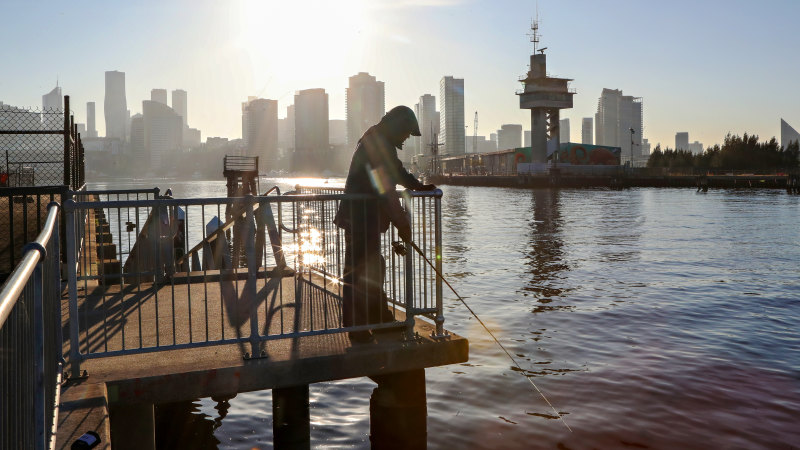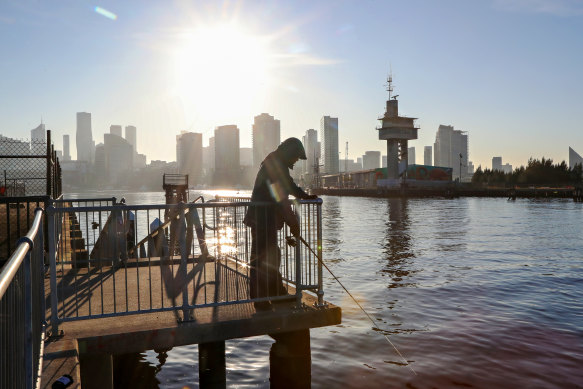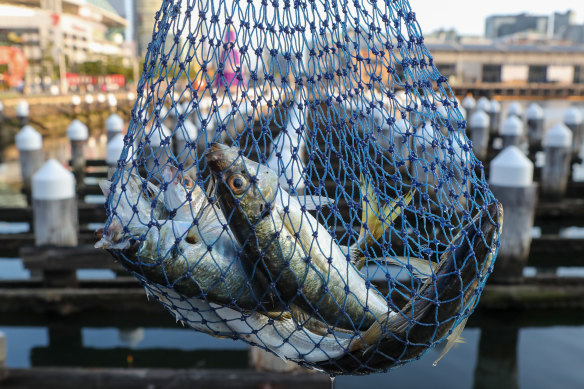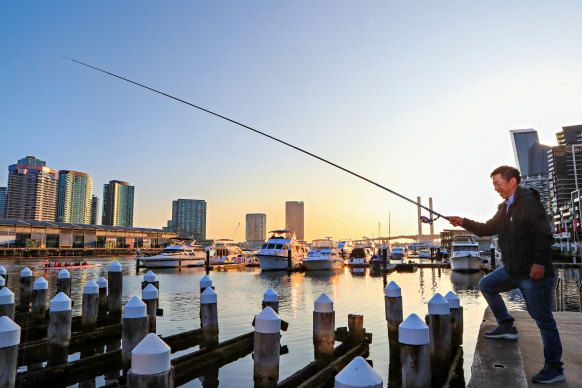Save articles for later
Add articles to your saved list and come back to them any time.
Fishermen are loath to reveal their secrets. When you find a good spot to cast a line, you keep it between yourself and the fish.
Ben Scullin can’t hide his best spots. Instead, he relies on incredulity. Suits-and-ties stop to gawk at the lone figure under the King Street bridge, tossing a line into the pea-soup-green Yarra – and ripping out wiggling bream, pinky snapper and flathead.
A fisherman casts his line into the Yarra River at Docklands as the sun rises over the Melbourne skyline.Credit: Paul Rovere
Fish seem attracted to city environments, urban fishers say – the wending waterways and, yes, tossed O-bikes essentially creating artificial reefs.
An urban fisher’s real prize: the “silver ghost”, bronze-green mulloway, which Scullin says grow as big as 15 kilograms under King Street.
Scullin works with a light line and lure, taking inspiration from the French, who started fishing zander, perch and catfish out of the Seine a decade ago. Scullin tosses back what he catches, but insists – despite the river’s dubious colouring – you could eat it if you wanted to.
“Certainly the health benefits of eating fish in the Yarra far outweigh any risks,” says Scullin, executive officer at VRFish.
Fisherman Zhi Yuan displays his yellowtail scad catch off the old pier at Docklands at sunset.Credit: Paul Rovere
Victoria’s Health Department warns fishers to be careful with catch from the lower Yarra; the waters can be contaminated with old industrial chemicals. Swimming is illegal.
That does not seem to deter many. They toss lines in off a pontoon under the West Gate Bridge, off crumbling Docklands jetties, or into the plumes of hot water dumped into the bay by the Newport Power Station; the heat attracts fat snapper and salmon, which can be hooked with little effort.
“Absolutely you can eat it,” says Travis Dowling, CEO of the Victorian Fisheries Authority. “Absolutely it is safe.
“These rivers are in terrific shape. And they support an incredible fishery. The Yarra is quite amazing.”
People think the Yarra is unhealthy “because it’s not crystal blue, like you might see in Scandinavia,” he says. But that colouring is from natural sediment, not pollution, he says. “The Yarra never ran blue.”
The truth of that is hard to judge. Some older fishers say it got much worse in the last 50 years. At the river’s source, in the Yarra Ranges, the water certainly runs clear.
“The river does have natural clay soils which give it a bit of a brown colour, but the brownness has been enhanced by invasive carp fish which feed on the river bottom and by agricultural run-off,” says Anthony Despotellis, spokesman for the Yarra Riverkeeper Association. “It’s gotten browner than it used to be, for sure.”
Ever since white settlement, we have been dumping our trash into the city’s waterways. Raw sewage flowed straight down the city’s streets and into the Yarra, mixing with lime sludge from tanneries and fertiliser from farms upstream. Gold miners brought mercury with them, which still pollutes some rivers. And then came factories that dumped PCB-laden muck into the waters.
Zhi Yuan fishes off the old pier in Docklands.Credit: Paul Rovere
Today, it’s the city itself. Our car tyres cover the roads in microplastics, while brake pads leave behind copper; rain leeches zinc off the facades of high-rise buildings. It all ends up in our rivers.
A 2018 report by the Commissioner for Environmental Sustainability into the Yarra’s health found 18 of 25 indicators of the river’s environmental health were in poor condition, including pollution, water quality, fish and sewage. Almost half of measured indicators were getting worse.
Tim Curmi, president of the Victorian arm of Native Fish Australia, says development along the riverbanks have deprived water-plants of the sunlight they need; combined with pollution and sewage the Yarra “isn’t that healthy”.
“I wouldn’t eat fish in the lower part of the Yarra at all,” Curmi says.
A Yarra riverkeeper checking his traps for polystyrene pollution.Credit: Jason South
RMIT eco-toxicologist Professor Vincent Pettigrove helped review the environmental stability report; his team spent last month dredging sediment from Port Phillip Bay, which they will take back to their lab and expose to snails and insects, to see if they sicken.
Thanks to decades of regulatory action, “many of the chemicals that were being accumulated in the food chain have disappeared – but there are some still”, he says.
But most remaining contaminants are heavy and tend to accumulate in sediment, not fish.
Generally, you can safely fish in most Victorian streams and bays, he says, as long as you follow the Environment Protection Authority’s guidelines: limit eels to one serving a month (they are more likely to accumulate contaminants) and fish to four servings. Other river health researchers agreed.
“Overall the water is relatively clean,” says Monash University water quality researcher Professor Perran Cook. “I would be happy to eat fish from the Yarra based on their guidelines.”
The Morning Edition newsletter is our guide to the day’s most important and interesting stories, analysis and insights. Sign up here.
Most Viewed in National
From our partners
Source: Read Full Article






